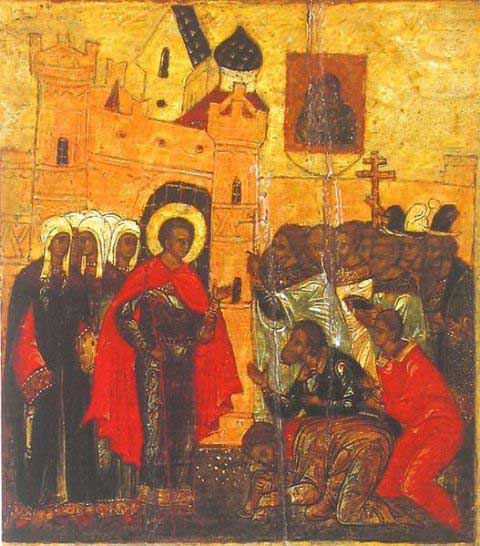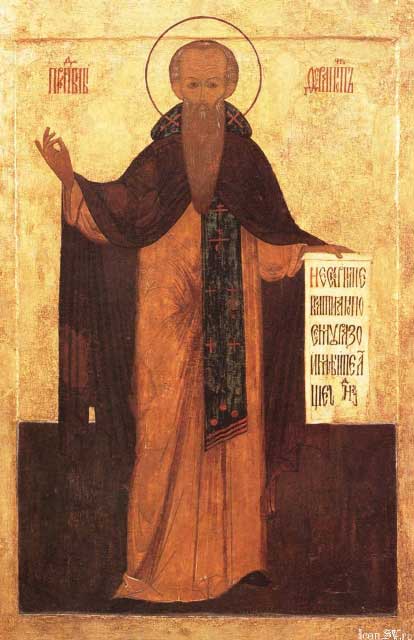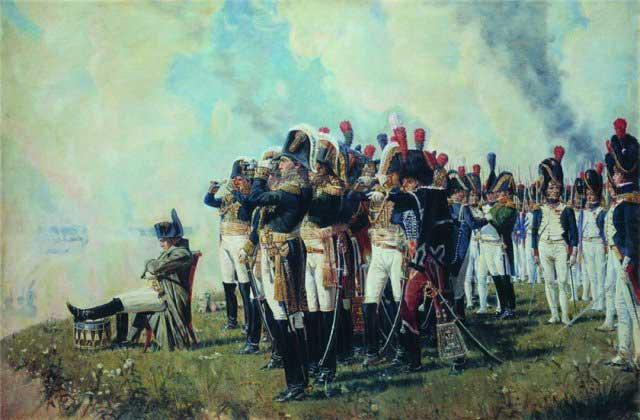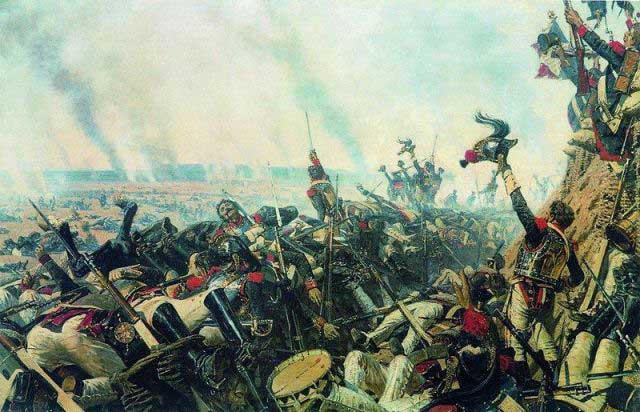History of Mozhaisk
13th Century
Mozhaisk Principality
 Mozhaisk was first mentioned in 1231 when it was a city in the Smolensk Principality and Prince Yaroslav Vsevolodovich of Vladimir attempted to seize it. In 1275 it became a separate part of the Smolensk Principality, known as the Mozhaisk Principality ruled by Fyodor Rostislavich the Black, the grandson of the then ruling Prince of Smolensk.
Mozhaisk was first mentioned in 1231 when it was a city in the Smolensk Principality and Prince Yaroslav Vsevolodovich of Vladimir attempted to seize it. In 1275 it became a separate part of the Smolensk Principality, known as the Mozhaisk Principality ruled by Fyodor Rostislavich the Black, the grandson of the then ruling Prince of Smolensk.
14th Century
Incorporation into the Moscow Principality
The Moscow Principality had its eyes set on Mozhaisk in order to control the whole length of the River Moskva. In 1303 Prince Yuri Danilovich of Moscow succeeded in capturing the city from Prince Gleb Rostislavich of Mozhaisk, a nephew of Prince Fyodor the Black. The Mozhaisk Principality was incorporated into Moscow. In 1389 Grand Prince Dmitri Donskoy gave his third son, Andrey Dmitrievich, Mozhaisk as an appendage which was then passed down through the descendants of Prince Andrey.
St Nicholas Mozhaisky
 According to legend in the 14th century Mozhaisk was being besieged by a Mongol-Tatar army and the locals had no other alternative than to pray for heavenly intervention for their city. Answering their prayers St Nicholas appeared in the stormy sky above them holding a glistening sword in one hand and an image of the city in his other hand. Upon seeing the appearance the Mongol-Tatars fled for their lives and the city was spared. The image of St Nicholas holding a sword and a model of a cathedral has since been used on icons which have become known as icons of St Nicholas Mozhaisky.
According to legend in the 14th century Mozhaisk was being besieged by a Mongol-Tatar army and the locals had no other alternative than to pray for heavenly intervention for their city. Answering their prayers St Nicholas appeared in the stormy sky above them holding a glistening sword in one hand and an image of the city in his other hand. Upon seeing the appearance the Mongol-Tatars fled for their lives and the city was spared. The image of St Nicholas holding a sword and a model of a cathedral has since been used on icons which have become known as icons of St Nicholas Mozhaisky.
15th Century
Luzhetsky Monastery
 In 1408 Prince Andrey of Mozhaisk invited the monk Ferapont, a disciple of St Sergius of Radonezh, to establish a monastery in Mozhaisk. The Luzhetsky Monastery was founded and dedicated to the Nativity of the Virgin Mary, in recognition of the fact that Dmitri Donskoy was victorious at the Battle of Kulikovo Field on 8 September which is the feast-day of the Nativity of the Virgin Mary. The monk Ferapont would later go on to found the more famous Ferapontova Monastery in the Vologda Region and be canonised as St Ferapont of Belozersk.
In 1408 Prince Andrey of Mozhaisk invited the monk Ferapont, a disciple of St Sergius of Radonezh, to establish a monastery in Mozhaisk. The Luzhetsky Monastery was founded and dedicated to the Nativity of the Virgin Mary, in recognition of the fact that Dmitri Donskoy was victorious at the Battle of Kulikovo Field on 8 September which is the feast-day of the Nativity of the Virgin Mary. The monk Ferapont would later go on to found the more famous Ferapontova Monastery in the Vologda Region and be canonised as St Ferapont of Belozersk.
17th Century
Time of Troubles
 In 1610 the Second False Dmitri briefly took Mozhaisk and then from 1610 to 1612 the city was occupied by Prince Władysław of Poland (later King Władysław IV). In 1618 Prince Władysław made a new attempt to capture the city during his campaign against Moscow but the city held out and did not fall. In 1624 Prince Dmitri Pozharsky ordered the construction of a stone kremlin in the city to replace the wooden one.
In 1610 the Second False Dmitri briefly took Mozhaisk and then from 1610 to 1612 the city was occupied by Prince Władysław of Poland (later King Władysław IV). In 1618 Prince Władysław made a new attempt to capture the city during his campaign against Moscow but the city held out and did not fall. In 1624 Prince Dmitri Pozharsky ordered the construction of a stone kremlin in the city to replace the wooden one.
19th Century
Battle of Borodino
 Twelve kilometres west of Mozhaisk in the village of Borodino, one of the most famous battles in Russian history took place. Napoleon invaded Russia with his Grande Armée on 24 June 1812, the start of what is known in Russia as the Patriotic War. The Grande Armée won several relatively minor battles but the main Russian army refused to give battle and retreated. The French decided to march on Moscow instead which would take them past Mozhaisk. The Russians retreated and employed the scorched-earth policy to deny the invaders of supplies. Finally the Russians engaged in battle on 7 September 1812 at what has become known as the Borodino Battlefield. The French Army was commanded by Napoleon himself while Mikhail Kutuzov was in charge of the Russians. The exact figures of casualties have been subject to debate for decades but the fact that it was the bloodiest battle of the Napoleonic Wars is not disputed; within a day over 30,000 troops were killed on each side.
Twelve kilometres west of Mozhaisk in the village of Borodino, one of the most famous battles in Russian history took place. Napoleon invaded Russia with his Grande Armée on 24 June 1812, the start of what is known in Russia as the Patriotic War. The Grande Armée won several relatively minor battles but the main Russian army refused to give battle and retreated. The French decided to march on Moscow instead which would take them past Mozhaisk. The Russians retreated and employed the scorched-earth policy to deny the invaders of supplies. Finally the Russians engaged in battle on 7 September 1812 at what has become known as the Borodino Battlefield. The French Army was commanded by Napoleon himself while Mikhail Kutuzov was in charge of the Russians. The exact figures of casualties have been subject to debate for decades but the fact that it was the bloodiest battle of the Napoleonic Wars is not disputed; within a day over 30,000 troops were killed on each side.
 Although the battle can be considered a victory for the French as the Russians withdrew from the battle and retreated, allowing the French to go on to capture a deserted Moscow, the Grande Armée's failure to destroy the Russian army meant that Napoleon's days in Russia were numbered, especially with the approaching winter and the drastic lack of supplies. After all Russia was able to replenish its army after the horrific losses at Borodino, Napoleon did not have this opportunity. The legacy of the importance attached to this battle can be seen in various famous Russian cultural works, from Pyotr Tchaikovsky's '1812 Overture' and paintings by various artist including Vasili Vereschagin to Lev Tolstoy's 'War and Peace' and Mikhail Lermontov's poem 'Borodino'. The Spaso-Borodinsky Monastery in Borodino was founded near to the battlefield in 1838 by the widow of General Tuchkov who fell at the battle.
Although the battle can be considered a victory for the French as the Russians withdrew from the battle and retreated, allowing the French to go on to capture a deserted Moscow, the Grande Armée's failure to destroy the Russian army meant that Napoleon's days in Russia were numbered, especially with the approaching winter and the drastic lack of supplies. After all Russia was able to replenish its army after the horrific losses at Borodino, Napoleon did not have this opportunity. The legacy of the importance attached to this battle can be seen in various famous Russian cultural works, from Pyotr Tchaikovsky's '1812 Overture' and paintings by various artist including Vasili Vereschagin to Lev Tolstoy's 'War and Peace' and Mikhail Lermontov's poem 'Borodino'. The Spaso-Borodinsky Monastery in Borodino was founded near to the battlefield in 1838 by the widow of General Tuchkov who fell at the battle.
20th Century
Second World War
 Like Napoleon before him, Hitler decided to pass through Mozhaisk to take Moscow. On the 16 October 1941 fighting broke out on the site of the Battle of Borodino and so this famous, almost sacred, battlefield also had a role in the Great Patriotic War, as the Second World War is known in Russia. After heavy fighting the Nazis managed to take control of the field and subsequently broke through to the Minskoe Shosse (Highway). Mozhaisk fell on 18 October 1941. During the occupation four partisan divisions operated in the city. By 19 January 1942 the Red Army had managed to encircle the city and finally liberated it in the morning of 20 January 1942. On the following day Borodino field was also retaken. In 2012 Mozhaisk was awarded the title of City of Military Glory.
Like Napoleon before him, Hitler decided to pass through Mozhaisk to take Moscow. On the 16 October 1941 fighting broke out on the site of the Battle of Borodino and so this famous, almost sacred, battlefield also had a role in the Great Patriotic War, as the Second World War is known in Russia. After heavy fighting the Nazis managed to take control of the field and subsequently broke through to the Minskoe Shosse (Highway). Mozhaisk fell on 18 October 1941. During the occupation four partisan divisions operated in the city. By 19 January 1942 the Red Army had managed to encircle the city and finally liberated it in the morning of 20 January 1942. On the following day Borodino field was also retaken. In 2012 Mozhaisk was awarded the title of City of Military Glory.

 History
History